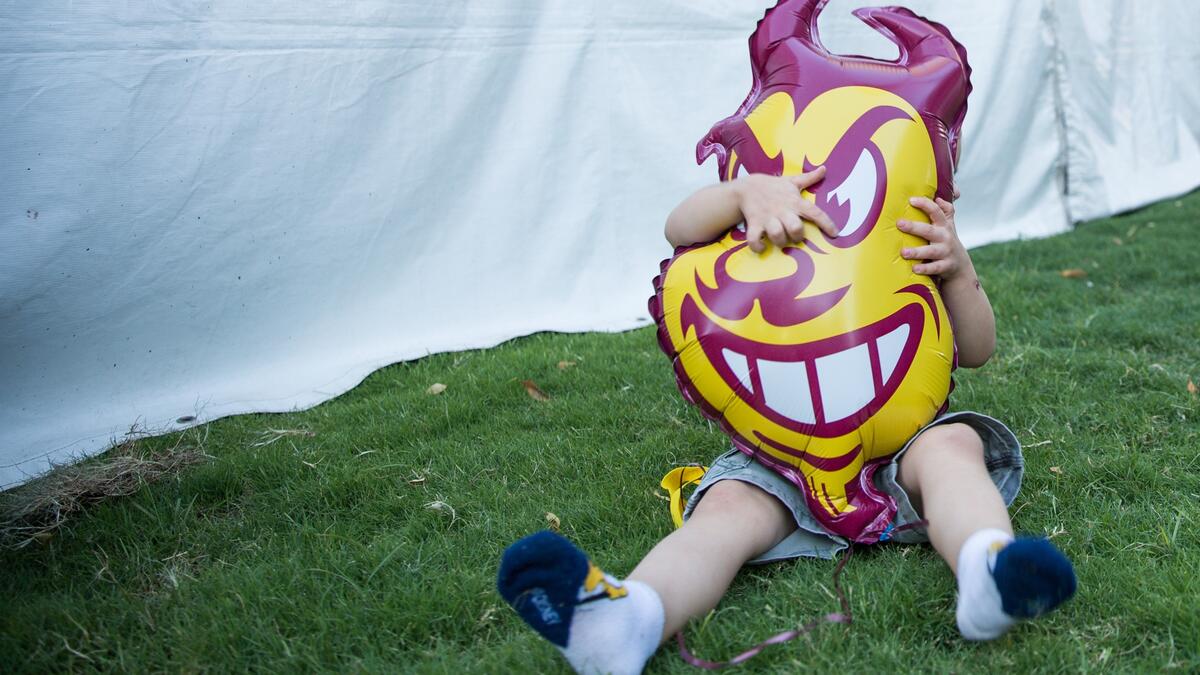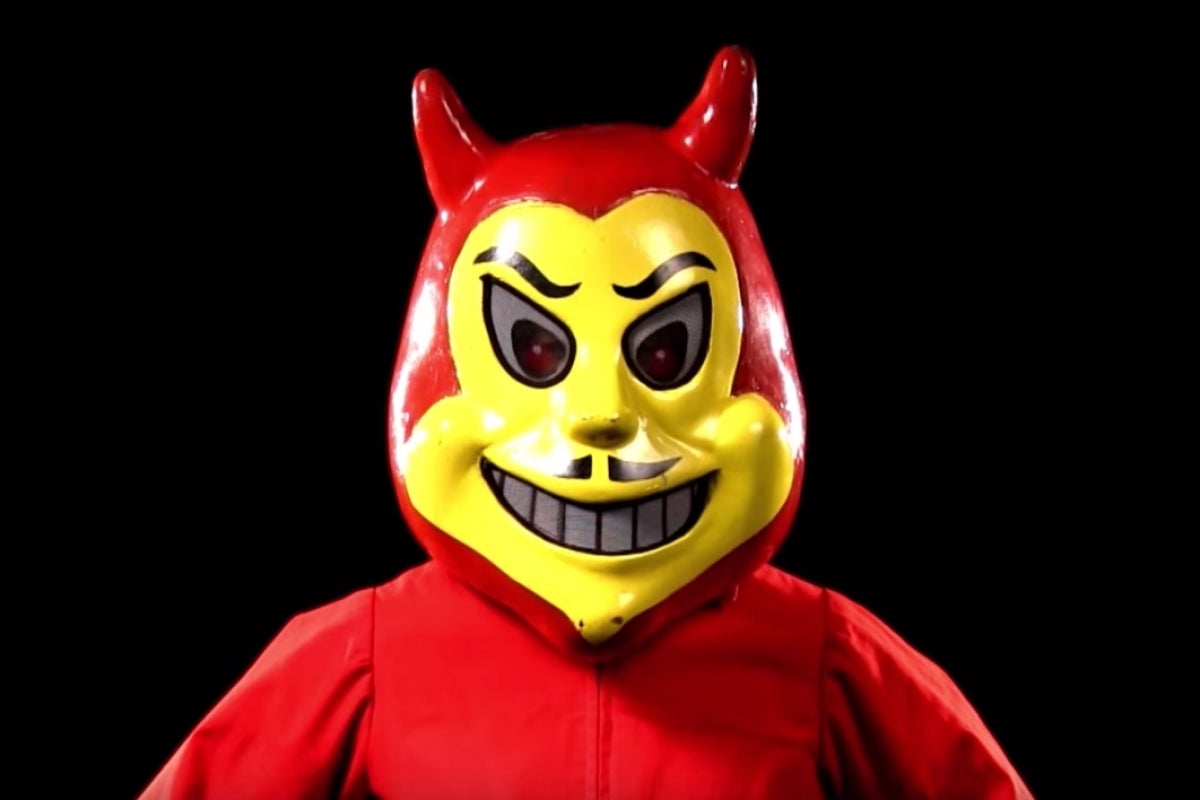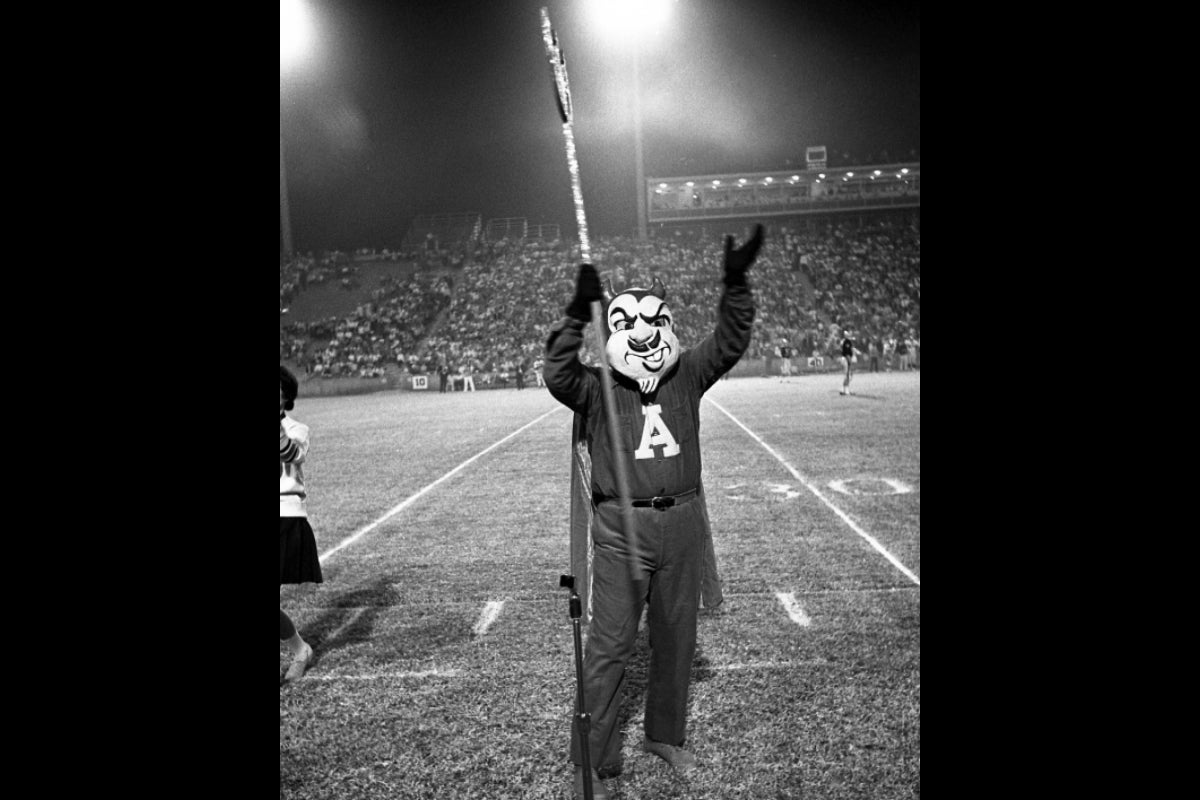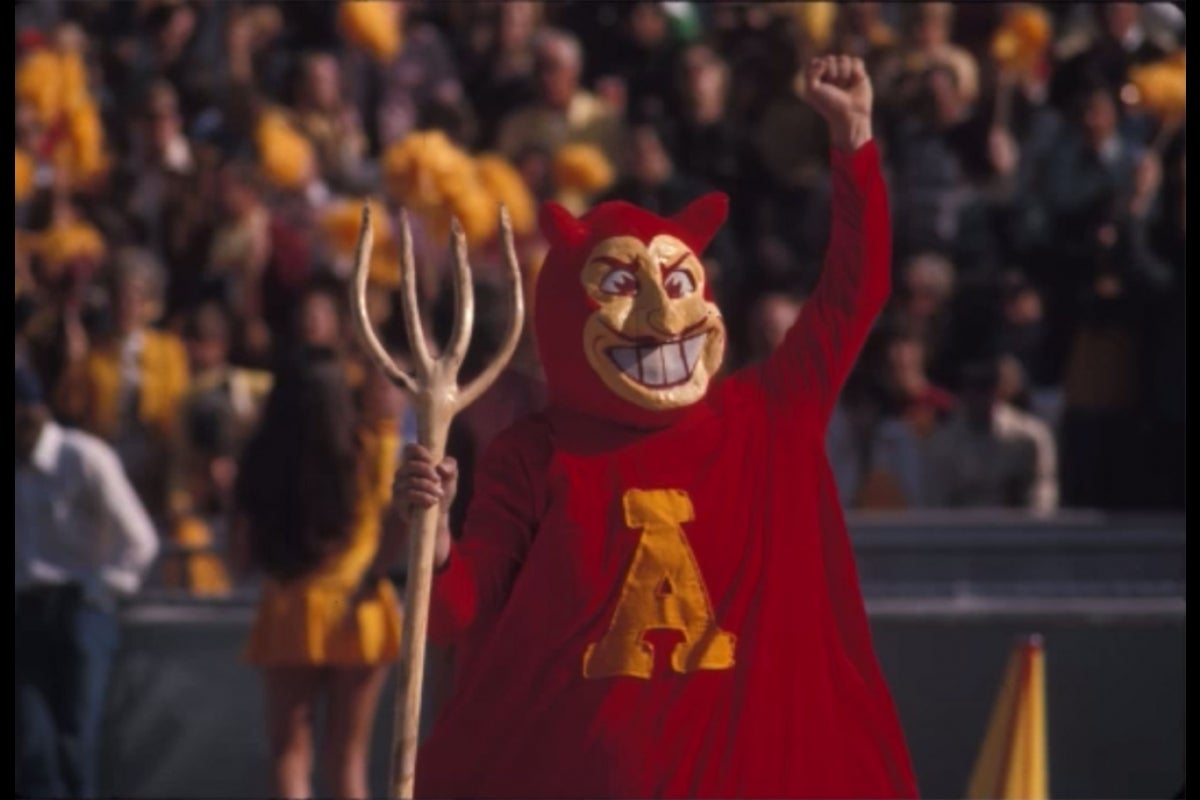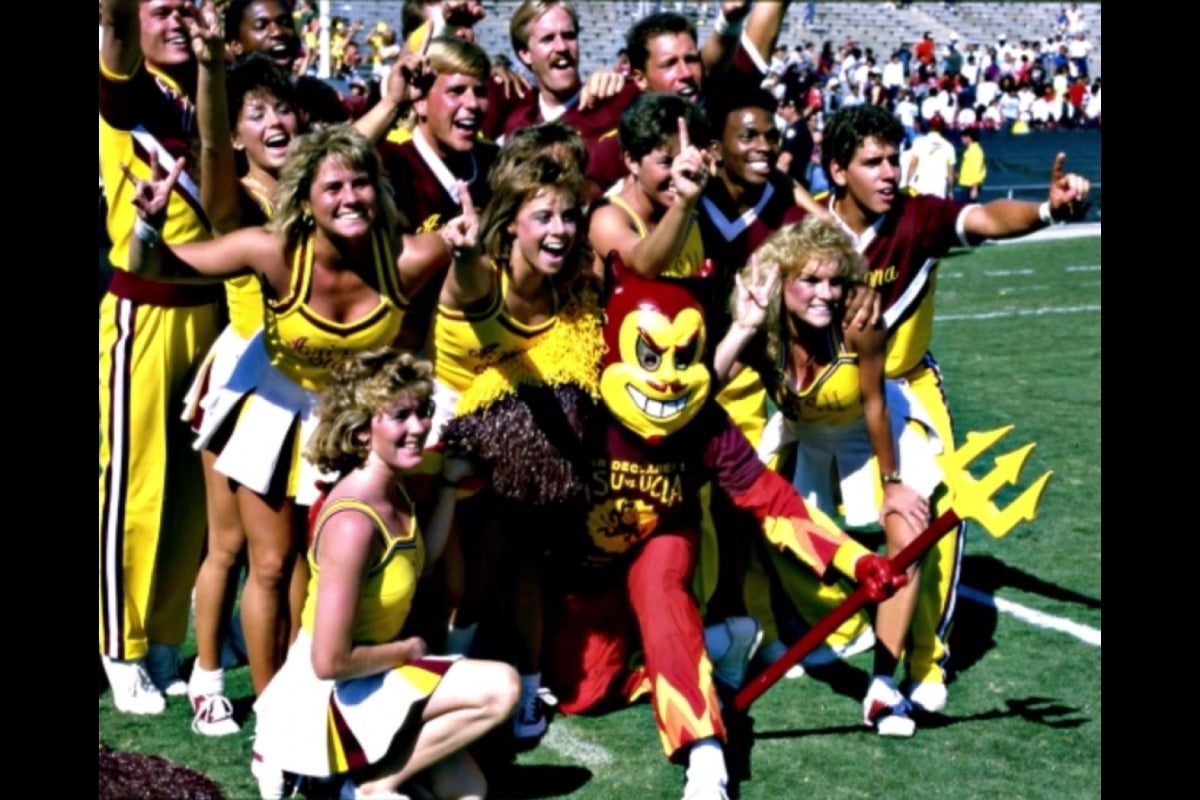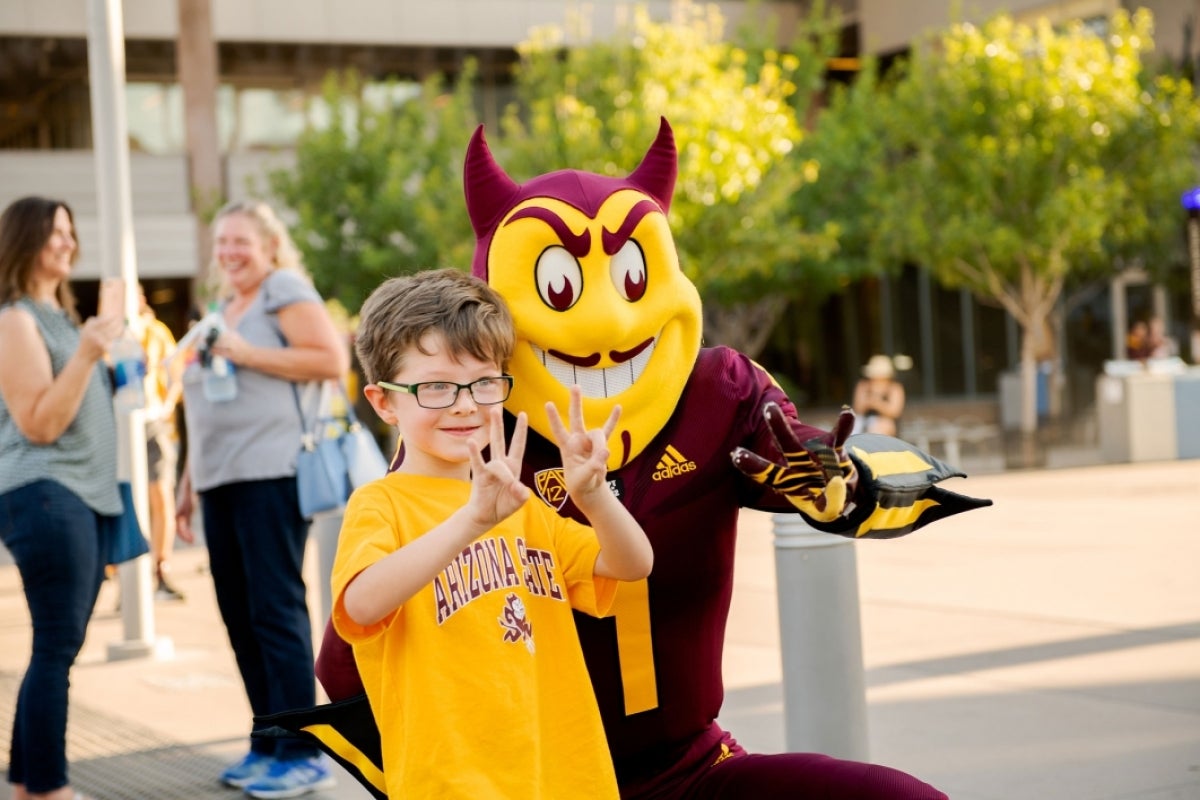On a clear, sunny day in 1946, Arizona State College track coach Donn Kinzle was on an early morning run along the Salt River bed. A dust devil materialized, swirling and dancing above the sand and rock.
At that instant, the idea for the Sun Devil was born.
More Hot Stuff than Mephistopheles, Arizona State University’s mascot turns 75 this Saturday, Nov. 20.
Dancing, prancing, crowd-surfing and crowd-pleasing, the pitchfork-wielding imp looks a lot different after seven and a half decades — who doesn’t? — but he’s passionately loved by his maroon and gold fans.
Consider the reaction to two news items last August: a survey listing the most offensive and creepy college mascots in America included Sparky on the eighth spot. Later the same week, a petition circulated calling on ASU to change its Sun Devils nickname to Sun Angels.
Social media and online comments boiled. The general response? “Fork that.”
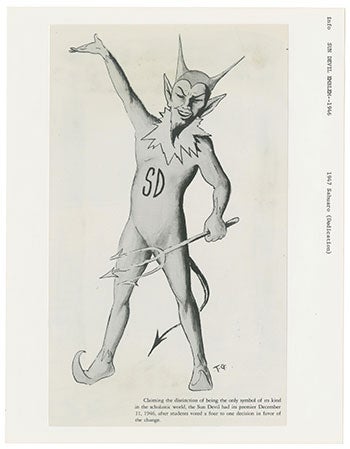
Original Sparky design, 1946 Arizona State College yearbook.
During the 1940s, Arizona State’s mascot was a bulldog. Bulldog mascots originated with Yale and continued with a string of colleges, notably the University of Georgia. University boosters worried the team name didn’t stand out. Arizona needed something that represented the institution’s place in the Southwest.
Three other higher education institutions have devils as their mascots: Duke University, Dickinson College and Central Connecticut State University. There are more than 100 high schools in the U.S. that use red devils as their mascots, according to CBS Sports.
“I personally think it's an advantage because a Sun Devil is something that's very unique and tied to Arizona's climate and culture,” said Tony Grandlienard, mascot manager for Sun Devil Athletics at ASU. “Whereas the school down south is a wildcat, I could probably tell you at least five to 10 schools that are also wildcats. So I think it gives us an edge in terms of school spirit. And I think Sparky just kind of brings a lot to the table in terms of his colors and personalities.”
After Arizona State Teachers College became Arizona State College in 1945, the student body voted 819 to 196 on Nov. 8, 1946, to make the change to the Sun Devils after frequent appeals to the student newspaper, the State Press. The moniker was officially adopted on Nov. 20, which is the date the university marks as Sparky's birthday.
Sparky was designed by artist and former Disney employee Berk Anthony in the late 1940s. But he was designed as a logo, not a mascot.
Sparky didn’t appear “in the flesh” until 1951, when he showed up at games wearing a satin jumpsuit with a long tail and carrying a pitchfork. He may be one of the earliest costumed sports mascots. Experts cite Mr. Met in baseball and Brutus Buckeye in college football, both debuting in 1964, as the first.
Played by gymnast, former Marine and ASU student Dick Jacobs, he performed dangerous stunts that would be forbidden today. He was also joined by two “Sparkettes,” Peggy Holiday and Peggy Sparkman.
Video by Ken Fagan/ASU News
Alan Wald played Sparky from 1980 to 1983. Without the Cardinals or Coyotes in the Valley, the Phoenix Suns and ASU were the only games in town back then, and the house was full at every game.
Since Wald couldn’t be an athlete, he decided to be Sparky. His parents were less than thrilled.
“Really? We sent you to school to be a mascot?” was their reaction, he said.
But being on the field, with 50,000 people roaring at him, there was “nothing like it.”
The suit was corduroy, zipped in front. It was no frills compared with the 2021 suit. Disney made the mask (which he still has).
Wald started the tradition of doing pushups for every point scored. At a Stanford game, Wald remembers he did 317 pushups. He was also the first Sparky to bring a flaming pitchfork on the field. (“That I stole from Florida State.”)
“It was an unbelievable experience,” said Wald, who works for a nonprofit trade association. It’s his claim to fame — that and being the father in the only father-son Sparky duo. His son, Kyle, later donned the horns and tail.
“People all have their own stories about Sparky,” Wald said.
But Sparky doesn’t have his own stories, because Sparky doesn’t speak. That’s verboten in the mascot realm, according to Grandlienard. No talking in the suit.
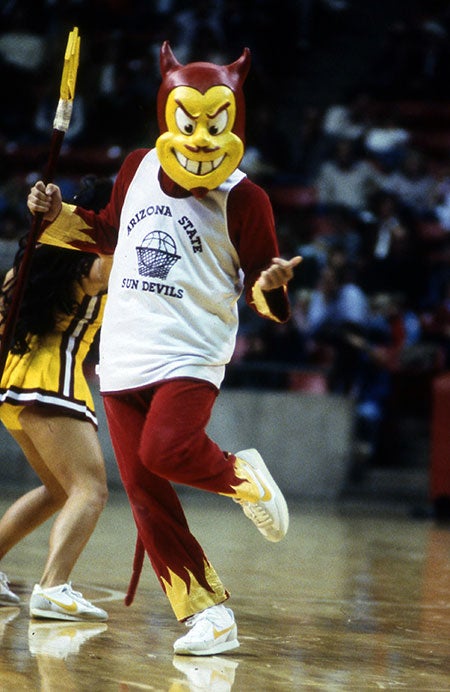
Sparky circa 1983, played by alum Alan Wald. ASU archive photo
What’s the process for becoming Sparky? There are tryouts once or twice a year. Can you do pushups? Can you be interactive with the crowd? Can you act in character based on your settings, i.e., imitate basketball moves during a basketball game or football moves during a football game?
And are you available? Sparky does more than 300 appearances every year. Off-campus, Sparky appears at weddings, bar mitzvahs, quinceañeras, 5K races, school visits — anything that’s not potentially damaging to the university’s reputation. (To date there has never been a request for Sparky to appear at a bachelor party.)
Sparky is a lot like Santa on Christmas. He’s in a lot of places at once. Athletics does all the sporting events and special requests. Each campus has a suit, as do some large colleges. (The W. P. Carey School of Business, the Ira A. Fulton Schools of Engineering and the alumni office all have their own suits.)
Without multiple Sparkys, Sun Devil Athletics would have three to five times more requests, as well as some exhausted kid racing from the West campus to the Polytechnic campus and everywhere in between in one day.
“We all communicate and do our best to make sure we don't have two Sparkys in the same area visible at the same time,” Grandlienard said. “Because of course that goes back to the mascot rules: There's only one that exists.”
It’s not always a young man in that suit. Women are accepted and welcome to try out for the part. (Currently there aren’t any women on the roster.)
“It's something that you probably wouldn't be able to tell because they're the same kind of height and weight as what we require in athletics,” Grandlienard said. “We’re completely on board with it as long as they can do the pushups.”
The devil has been cast from the stadium only once, when the Pope visited Arizona. Pope John Paul II came to the Valley in September 1987. The pontiff held an evening Mass at Sun Devil Stadium for more than 75,000 people. ASU charged almost $200,000 for the event to be held there, but the Vatican had one stipulation: All images of Sparky (and the pitchfork) had to be covered.
Sparky “would tell you it is what it is,” Grandlienard said. “He's glad that he was on the stadium banners and whatnot. But just speaking for the university, we wanted to respect the magnitude of something like that occurring at Sun Devil Stadium and wanting to take proper precautions and preserving that image and respecting their traditions as well.”
Where does Sparky go from here?
“It's full steam ahead for Sparky,” Grandlienard said. “And we're excited that he's had 75 years of experiences and changes and stuff to add to his legacy.”
Top image: Cameron Kling, 3, plays with his Sparky balloon at the 2017 Homecoming Block Party. Cameron's father, Shannon, is an ASU alumnus and hopes his son will attend the school as well. Photo by Anya Magnuson/ASU News
More Sun Devil community

Open Doors report: ASU’s doors are open to the world
For the fourth straight year, Arizona State University is being recognized as the top public university choice of international students by the Institute of International Education in its annual…

ASU students receive $25,000 scholarships from NBA legend Magic Johnson
By Henry Smardo Serenity Reynolds Cronkite student Serenity Reynolds balances classes, homework, clubs, internships and jobs, and tuition is always top of mind. She…

ASU Accessibility Awareness Day advocates for a more inclusive digital future
By Jonathan CrowellAs technology continues to drive learning and research innovations, so do efforts to ensure digital products and environments are accessible by all.Last week, Arizona State…
